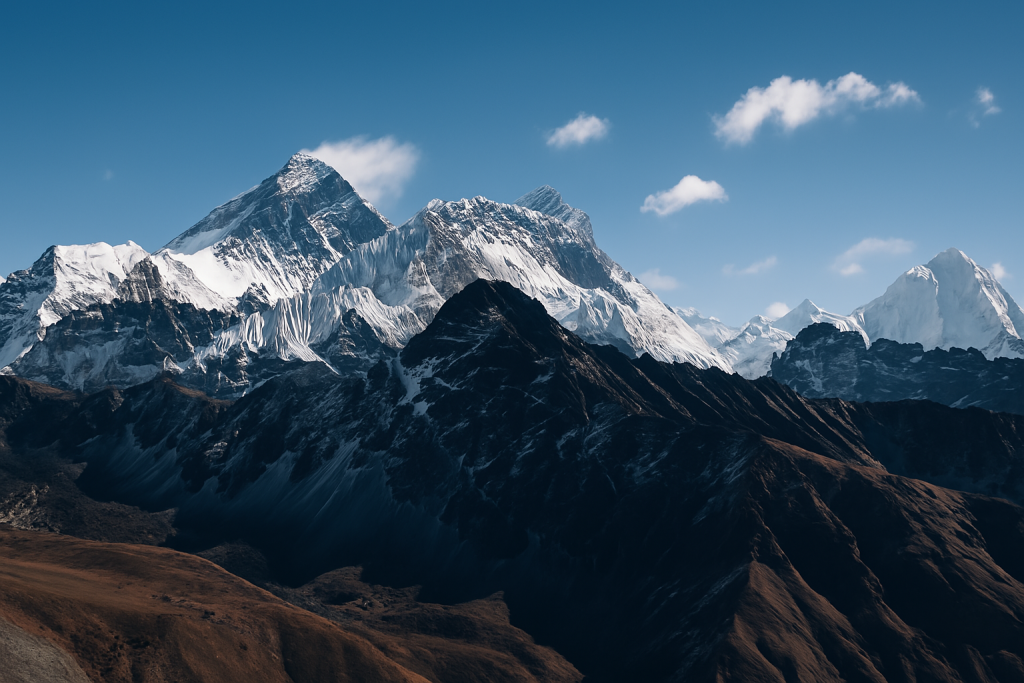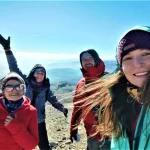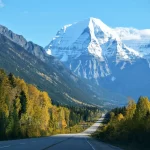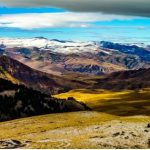Highest Mountains in Nepal (Top 10)
Nepal is a mountainous country nestled in the heart of the Himalayas, home to 8 of the world’s 14 peaks that rise above 8,000 meters. These mountains are not only known for their height but also for their cultural, geological, and ecological significance. Most of Nepal’s major peaks demand technical climbing skills, making them ideal for seasoned mountaineers. What makes them even more special is the spiritual connection that local communities—such as the Sherpas—maintain with these mountains, often considering them sacred beings rather than just geological formations. Highest Mountains in Nepal (Top 10)
The climate in the high Himalayas is harsh, with sudden weather changes and a high risk of avalanches, especially at extreme altitudes. Nevertheless, trekking routes and base camp experiences offer breathtaking opportunities for adventurers of all levels. Beyond just physical challenges, Nepal’s mountains offer a spiritual journey and a deep connection to nature. They stand as some of the most awe-inspiring and meaningful landscapes on Earth, blending human humility with natural grandeur.
Mount Everest (8,848.86 m) The Roof of the World: Where Human Spirit Touches the Sky
Mount Everest, the roof of the world, stands tall at 8,848.86 meters and is the ultimate dream of every mountaineer. Located on the Nepal-Tibet border, Everest is more than just a mountain—it’s a symbol of human endurance and ambition. Personally, what fascinates me most about Everest is the cultural harmony it embodies; the Sherpa community, prayer flags fluttering in the wind, and the spiritual significance it holds in both Nepali and Tibetan traditions. Despite the commercialization, standing at Base Camp, feeling the crisp air and hearing the whisper of the Khumbu Icefall, is surreal. From a technical SEO standpoint, “Mount Everest” is a high-volume keyword, perfect for content about trekking, mountaineering, and adventure travel. Semantically, combining terms like “Everest expedition,” “Sagarmatha,” and “highest mountain in the world” adds depth and relevance. Click here for detailed information about Mount Everest
Mount Kanchenjunga (8,586 m) The Sacred Sentinel: Silence, Solitude, and Himalayan Soul
Kanchenjunga, the second-highest mountain in Nepal and the third in the world, is a giant of solitude. At 8,586 meters, it remains one of the least climbed peaks due to its remote location and technical challenges. What I love about Kanchenjunga is its raw, untouched beauty and the spiritual aura it radiates. Locals believe its summit is sacred, which is why climbers traditionally stop a few meters short of the top. The journey to its base camp feels like stepping into a forgotten world—lush forests, rare wildlife, and a profound silence. For SEO, terms like “Kanchenjunga trek,” “remote Himalayan trekking,” and “sacred peaks of Nepal” are excellent long-tail keywords. Semantically, using expressions like “hidden gem,” “pristine wilderness,” and “cultural heritage” can enhance the narrative and search relevance.Click here for detailed information about Mount Kanchenjunga
Mount Lhotse (8,516 m) The Hidden Giant: Sharp Ridges and Raw Adrenaline
Lhotse, Everest’s formidable neighbor, often goes unnoticed despite being the fourth-highest mountain in the world at 8,516 meters. What draws me to Lhotse is its sharp ridgelines and the dramatic Lhotse Face—a wall of ice that demands technical prowess and nerves of steel. Sharing the same route as Everest until Camp 3, Lhotse offers a challenging yet less crowded alternative. It’s a climber’s mountain, favored by those seeking adventure beyond the mainstream. SEO-wise, keywords like “Lhotse climbing route,” “Everest Base Camp alternative,” and “technical Himalayan climbs” are valuable. Semantically, terms like “ice wall,” “vertical ascent,” and “extreme altitude” help reinforce topic relevance. In my view, Lhotse is the hidden beast of the Himalayas, often overshadowed, but never outclassed. Click here for detailed information about Mount Lhotse
Mount Makalu (8,485 m) The Solitary Pyramid: Fierce, Untamed, and Majestic
Makalu, rising to 8,485 meters, is a stunning, isolated peak known for its perfect pyramid shape. It’s the fifth-highest mountain in the world and lies just 19 kilometers southeast of Everest. What makes Makalu special to me is its fierce independence. The journey to its base is remote and wild, cutting through the Makalu Barun National Park—an ecosystem brimming with life and mystery. Climbing Makalu is not for the faint-hearted; it’s steep, exposed, and less commercialized, which adds to its allure. From an SEO perspective, keywords like “Makalu expedition,” “off-the-beaten-path Nepal,” and “technical Himalayan peaks” are strong performers. Semantically, phrases such as “untouched landscapes,” “alpine challenges,” and “hidden Himalayan treasure” align well with search intent and storytelling.Click here for detailed information about Mount Makalu
Mount Cho Oyu (8,188 m) The Gentle Giant: Gateway to the Himalayan Realm
Cho Oyu, meaning “Turquoise Goddess” in Tibetan, stands at 8,188 meters and is often considered the most approachable of the 8,000-meter peaks. It’s located near the Nangpa La pass, a traditional trade route between Nepal and Tibet. What I appreciate about Cho Oyu is how it welcomes climbers—it’s less technical, yet high enough to offer a true Himalayan experience. It’s perfect for acclimatization and for those preparing for Everest. Personally, the gentle slopes, the panoramic views, and the spiritual vibe of the region make it a heartwarming climb. For SEO, keywords like “Cho Oyu climb,” “8000-meter beginner peak,” and “accessible Himalayan mountains” are beneficial. Semantically, using terms like “entry-level 8000er,” “high-altitude trekking,” and “Tibetan border views” enriches the content and boosts search performance. Click here for detailed information about Mount Cho Oyu
Mount Dhaulagiri I (8,167 m) The White Fortress: Isolated Beauty in a Towering Form
Dhaulagiri I, the seventh-highest mountain in the world, rises to an imposing 8,167 meters and stands apart with its raw and massive profile. Located in western Nepal, it dominates the Kali Gandaki Valley and offers one of the greatest vertical ascents in the world. What deeply resonates with me is its majestic solitude—less commercialized, more remote, and a real test for seasoned mountaineers. Its name means “White Mountain,” a fitting tribute to its snow-clad slopes that shimmer in the Himalayan sun. The trek to its base camp is physically demanding but richly rewarding, filled with alpine meadows and towering cliffs. For SEO, use keywords like “Dhaulagiri expedition,” “remote Nepal climbs,” and “Kali Gandaki trek.” Semantically, integrate phrases such as “challenging ascent,” “snow-capped giant,” and “underrated Himalayan peak” for better keyword relevance and thematic depth. Click here for detailed information about Mount Dhaulagiri
Manaslu (8,163 m) Mountain of the Spirit: Where Tranquility Meets Challenge
Manaslu, the eighth-highest mountain in the world at 8,163 meters, is often called the “Mountain of the Spirit.” Situated in the Gorkha region, it’s surrounded by rich cultural heritage and natural beauty. Personally, I find Manaslu’s appeal lies in its balance—remote yet accessible, challenging yet not extreme. The Manaslu Circuit Trek is a favorite among trekkers who wish to avoid the crowded Annapurna trails. Climbing the peak itself is a serious undertaking, requiring technical skill and acclimatization, but it’s far less trafficked than Everest or Annapurna I. SEO-wise, terms like “Manaslu trek,” “offbeat Himalayan trekking,” and “cultural Nepal expedition” are effective. Semantically, enriching the text with phrases like “hidden valley,” “local tea houses,” and “sacred mountain spirit” builds emotional and contextual relevance. Click here for detailed information about Mount Manaslu
Annapurna I (8,091 m) Deadly Grace: The Allure and Peril of a Himalayan Queen
Annapurna I, standing at 8,091 meters, is both revered and feared. It has one of the highest fatality rates among the 8,000ers, earning it a reputation as a deadly beauty. What draws me to Annapurna I is this paradox—it’s breathtakingly beautiful yet demands deep respect. Located in central Nepal, it’s part of the wider Annapurna Massif, which hosts some of Nepal’s most beloved trekking routes. Personally, the spiritual and physical intensity of this mountain fascinates me. Climbers must be well-prepared for avalanches and rapidly changing weather. For SEO optimization, focus on keywords like “Annapurna I summit,” “deadliest Himalayan climb,” and “central Nepal peaks.” Semantically, leverage emotional and dramatic terms like “fatal attraction,” “ice-clad throne,” and “treacherous trails.” Click here for detailed information about Mount Annapurna I
Gyachung Kang (7,952 m) The Silent Purist: Underrated, Unspoiled, Unforgettable
Gyachung Kang, though not an 8,000-meter peak, is the highest mountain below that threshold, standing proudly at 7,952 meters. It’s nestled between Everest and Cho Oyu and is often overlooked due to its slightly lower elevation. But for me, that’s part of the charm. It’s a mountain for purists—steep, technical, and remote. Few climbers attempt it, which preserves its pristine and wild character. Its ridgelines are jagged, its slopes unwelcoming, and its atmosphere, hauntingly quiet. SEO-wise, use keywords like “Gyachung Kang climb,” “hidden Himalayan peaks,” and “technical mountaineering in Nepal.” Semantically, expressions such as “untouched by crowds,” “remote splendor,” and “pure alpine challenge” add richness and uniqueness to the narrative. Click here for detailed information about Mount Gyachung Kang
Annapurna II (7,937 m) The Hidden Hero: The Elegance in the Shadows
Annapurna II, at 7,937 meters, is the eastern anchor of the Annapurna range and often overshadowed by its more infamous sibling, Annapurna I. However, it possesses its own grandeur—sleek ridges, dramatic snow flutes, and towering walls that draw in true adventurers. I see Annapurna II as the dark horse of the range: beautiful, underestimated, and fiercely independent. Its technical sections and avalanche-prone areas mean it’s not for the inexperienced. Yet its location near the Annapurna Circuit makes it more visible and tempting for trekkers and climbers alike. For SEO purposes, target phrases like “Annapurna II expedition,” “eastern Himalaya peak,” and “underrated mountains of Nepal.” Semantically, include terms like “hidden alpine marvel,” “technical ascent,” and “remote high-altitude beauty” to appeal to search engines and readers simultaneously. Click here for detailed information about Mount Annapurna II





